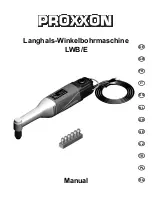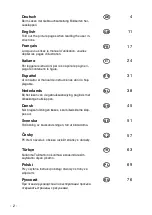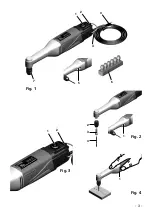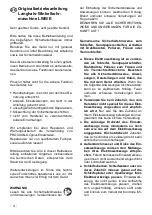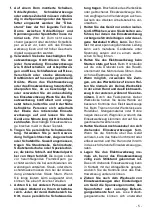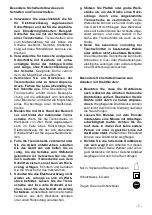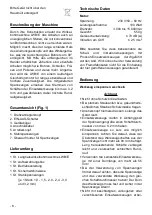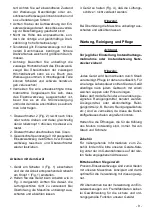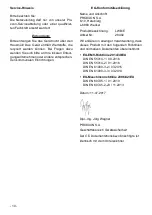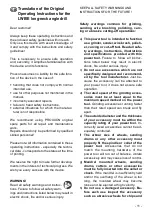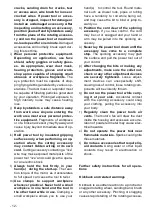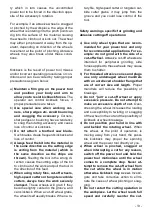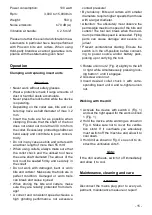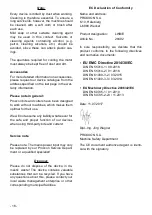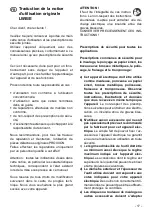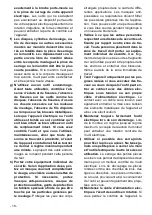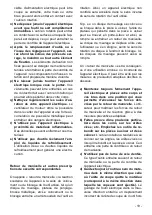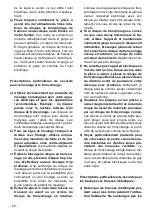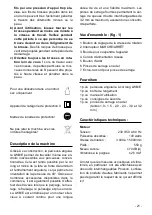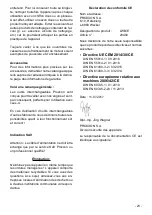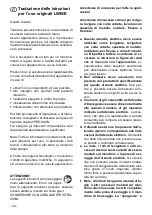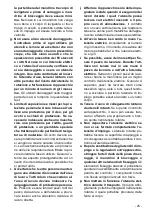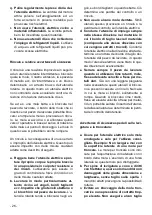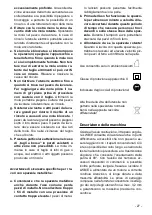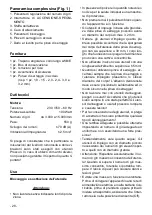
ry which in turn causes the uncontrolled
power tool to be forced in the direction oppo-
site of the accessory’s rotation.
For example, if an abrasive wheel is snagged
or pinched by the workpiece, the edge of the
wheel that is entering into the pinch point can
dig into the surface of the material causing
the wheel to climb out or kick out. The wheel
may either jump toward or away from the op-
erator, depending on direction of the wheel’s
movement at the point of pinching. Abrasive
wheels may also break under these condi-
tions.
Kickback is the result of power tool misuse
and/or incorrect operating procedures or con-
ditions and can be avoided by taking proper
precautions as given below.
a)
Maintain a firm grip on the power tool
and position your body and arm to
allow you to resist kickback forces.
The
operator can control kickback forces, if
proper precautions are taken.
b)
Use special care when working cor-
ners, sharp edges etc. Avoid bouncing
and snagging the accessory.
Corners,
sharp edges or bouncing have a tendency
to snag the rotating accessory and cause
loss of control or kickback.
c)
Do not attach a toothed saw blade.
Such blades create frequent kickback and
loss of control.
d)
Always feed the bit into the material in
the same direction as the cutting edge
is exiting from the material (which is
the same direction as the chips are
thrown).
Feeding the tool in the wrong di-
rection causes the cutting edge of the bit
to climb out of the work and pull the tool in
the direction of this feed.
e)
When using rotary files, cut-off wheels,
high-speed cutters or tungsten carbide
cutters, always have the work securely
clamped.
These wheels will grab if they
become slightly canted in the groove, and
can kickback. When a cut-off wheel grabs,
the wheel itself usually breaks. When a ro-
tary file, high-speed cutter or tungsten car-
bide cutter grabs, it may jump from the
groove and you could lose control of the
tool.
Safety warnings specific for grinding and
abrasive cutting-off operations:
a)
Use only wheel types that are recom-
mended for your power tool and only
for recommended applications. For ex-
ample: do not grind with the side of a
cut-off wheel.
Abrasive cut-off wheels are
intended for peripheral grinding, side
forces applied to these wheels may cause
them to shatter.
b)
For threaded abrasive cones and plugs
use only undamaged wheel mandrels
with an unrelieved shoulder flange that
are of correct size and length.
Proper
mandrels will reduce the possibility of
breakage.
c)
Do not “jam” a cut-off wheel or apply
excessive pressure. Do not attempt to
make an excessive depth of cut.
Over-
stressing the wheel increases the loading
and susceptibility to twisting or snagging
of the wheel in the cut and the possibility of
kickback or wheel breakage.
d)
Do not position your hand in line with
and behind the rotating wheel.
When
the wheel, at the point of operation, is
moving away from your hand, the possi-
ble kickback may propel the spinning
wheel and the power tool directly at you.
e)
When wheel is pinched, snagged or
when interrupting a cut for any reason,
switch off the power tool and hold the
power tool motionless until the wheel
comes to a complete stop. Never at-
tempt to remove the cut-off wheel from
the cut while the wheel is in motion
otherwise kickback may occur.
Investi-
gate and take corrective action to elimi-
nate the cause of wheel pinching or snag-
ging.
f)
Do not restart the cutting operation in
the workpiece. Let the wheel reach full
speed and carefully re-enter the cut.
- 13 -
Содержание LWB/E
Страница 1: ...DE GB FR IT ES NL DK SE CZ TR PL RU Manual Langhals Winkelbohrmaschine LWB E ...
Страница 3: ...1 1 2 1 3 2 4 Fig 1 3 Fig 3 Fig 2 Fig 4 7 6 1 2 4 3 5 1 2 7 1 2 2 1 1 3 4 5 6 4 ...
Страница 86: ... 86 Notizen ...
Страница 87: ... 87 Notizen ...
Страница 88: ... 88 Notizen ...

